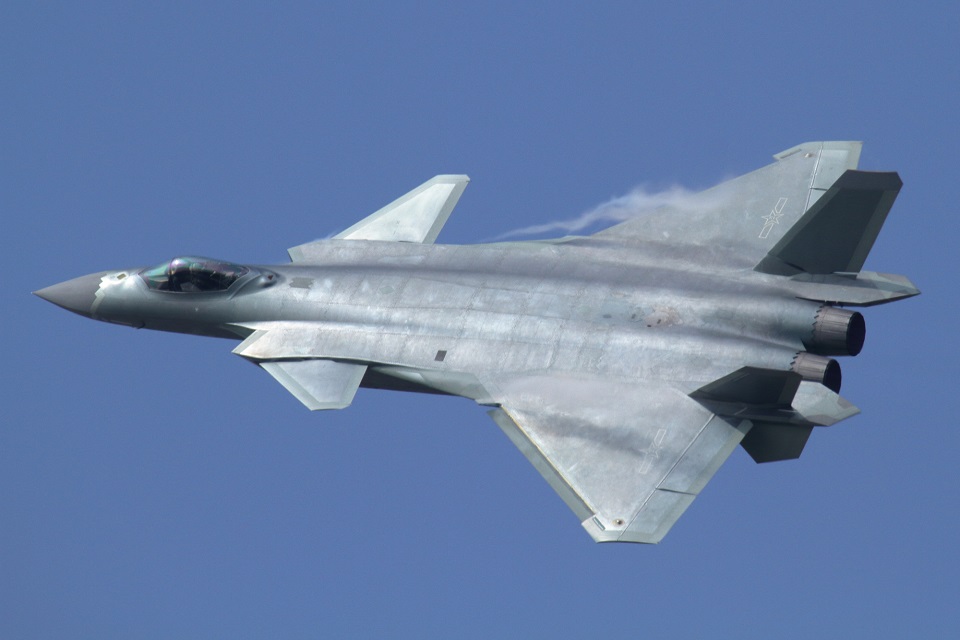Aerospace
China’s Fighter Jets Turn Wings into Autonomous Drones

In a striking display of aerospace innovation, Chinese engineers have reportedly tested a groundbreaking “combiner” blended-wing stealth aircraft with detachable drone wings.
This transformative technology, reminiscent of fictional “combiner” Transformers, was showcased during a test flight at an undisclosed airport near the Mu Us Desert’s southern edge.
The stealth fighter, equipped with powerful twin-engine turbofans and a sleek delta-wing design, demonstrated unprecedented versatility. During the flight, segments of its wings detached, seamlessly transforming into two separate “flying wing” drones powered by electric fans.
This capability marks a significant leap in aerial warfare, enabling the fighter to deploy autonomous drones mid-flight for strategic operations.
Future stealth fighters will prioritize integration with drones
Yang Wei, chief designer of China’s J-20 stealth fighter, emphasized that future iterations will prioritize seamless integration with drones. The development includes plans for a two-seater variant of the J-20 to enhance operational coordination with unmanned aerial vehicles (UAVs), reflecting China’s strategic focus on combined arms tactics.
The next-generation stealth fighter design integrates two drones directly into the aircraft’s delta wing structure, departing from earlier attempts that fixed drones to wingtips.
This innovative “rear edge docking configuration,” connecting leading edges of the drones to the fighter’s trailing edge, enhances stability during separation. However, it poses challenges such as managing significant changes in the aircraft’s center of gravity and aerodynamic balance.
FCC-100 flight control computer ensures precise control
To address these complexities, Du’s team developed advanced algorithms capable of analyzing and compensating for disturbances like wind changes during drone separation. Both the fighter and the drones utilize the cutting-edge FCC-100 flight control computer from Northwestern Polytechnical University, ensuring precise control and maneuverability.
While specific details about the test flight date remain classified, the project signifies remarkable advancements in aircraft stability and control. These developments pave the way for practical applications in future combat scenarios.
Chinese scientists are also exploring additional technologies like plasma stealth and advanced airflow management to further enhance the capabilities of their next-generation fighters.

Aerospace
When Ratan Tata was denied entry to the airfield at the Aero India show, he waited

During our visit to Aero India 2019, we had the unexpected opportunity to see Ratan Tata at the event, which was a thrilling moment for us. However, there was a surprising hiccup when the security staff didn’t allow him to enter due to a lack of a security pass.
Despite this, he remained calm and patiently waited for about 20 minutes until a member of the Tata team brought him the required pass, after which he calmly proceeded inside. It was a humbling sight, showcasing his composed demeanor even in such situations.
Ratan Tata ji is not only a renowned industrialist but also a trained pilot, holding a pilot’s license. In 2007, he became the first Indian civilian to fly the F-16 Falcon during the Aero India show in Bangalore—a proud moment for the nation.
His passion for aviation extended beyond flying, as he played a key role in shaping India’s aerospace industry. Under his leadership, Tata ventured into manufacturing and maintaining aerospace components while upholding its legacy of quality. Notably, Tata’s collaboration with Airbus to develop and manufacture the C295 aircraft is a testament to its growing influence in the sector.
-

 Aviation2 months ago
Aviation2 months agoMicrosoft Flight Simulator Raises $3 Million to Bring Back the An-225 Mriya
-

 Airlines2 months ago
Airlines2 months agoQantas Engineers Stage Walkout Over Cost of Living Concerns
-

 Airlines2 months ago
Airlines2 months agoQatar Citizens Can Travel to the United States Without a Visa
-

 Aviation2 months ago
Aviation2 months agoQatar Airways bans these new Electronic Devices on plane
-

 Airlines2 months ago
Airlines2 months agoJapan Airlines Rolls Out Free Domestic Flights to International Passengers
-

 Defence2 months ago
Defence2 months agoWhich Country Has the Largest Fleet of Fighter Aircraft?
-

 Airport2 months ago
Airport2 months agoWestern Sydney Airport Welcomes Its First Plane After 6 Years of construction
-

 Aviation2 months ago
Aviation2 months agoDid you know ? Once Boeing 747 carried 1088 passenger in 1991








